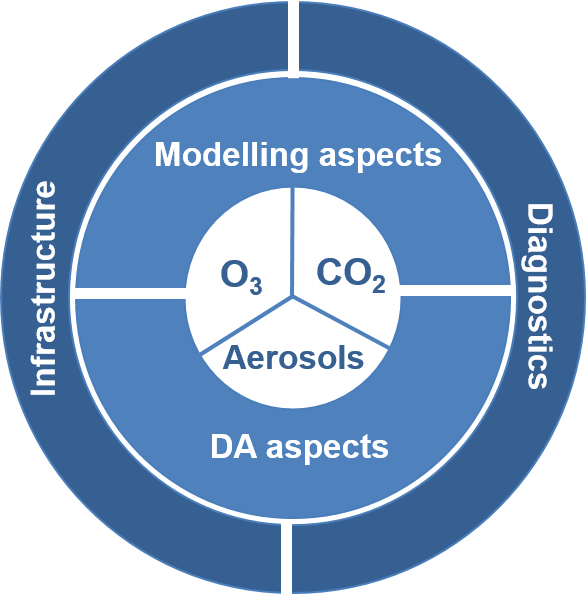One of ECMWF’s strategic goals for 2025 is to develop an integrated global model of the Earth system to produce forecasts with increasing fidelity on time ranges up to a year ahead. This will be achieved by incorporating an increased level of complexity of physical and chemical processes and of the interactions between the atmosphere, the ocean, sea ice and the land surface into the model. Atmospheric composition has the potential to be one of the sources of predictability at different timescales. Development activities at ECMWF have built a capacity to simulate and assimilate a variety of atmospheric composition species in the Integrated Forecasting System (IFS). Today this capacity is at the core of the Copernicus Atmosphere Monitoring Service (CAMS) implemented by ECMWF on behalf of the EU.
It is worth noting that the complexity of many atmospheric composition modules in the IFS means that they are often computationally unaffordable at the resolutions used in numerical weather prediction (NWP). Only stratospheric ozone is a prognostic variable in NWP applications, and it is included interactively in the radiative transfer model used for radiance assimilation. In contrast, the radiation scheme still relies on climatologies of aerosols, ozone and trace gases. Considerable collaborative effort has been made in the last few years to build these climatologies from CAMS products with the aim of improving the realism of the atmospheric composition fields in the radiative calculations and of the related weather feedbacks.
Members of the ECMWF ACWG R. Dragani, A. Benedetti, J. Flemming, G. Balsamo, M. Diamantakis, A. Geer, R. Hogan, T. Stockdale, M. Ades, A. Agusti‑Panareda, J. Barre, P. Bechtold, A. Bozzo, H. Hersbach, E. Hόlm, A. Inness, S. Johnson, Z. Kipling, J. Letertre‑Danczak, S. Massart, M. Matricardi, T. McNally, M. Parrington, I. Sandu, C. Soci, and F. Vitart.
Working group recommendations
A cross-departmental working group on atmospheric composition (ACWG) was set up at ECMWF in spring 2018. Its main concern to date has been to identify a set of priority developments that have the potential to improve forecasts at all scales, from a few days to seasons ahead. The aim is to assess their potential in the time frame 2019–2022 and, where benefits exist, to proceed with operational implementation.
The ACWG suggests improving the representation of atmospheric composition in NWP to the level of complexity and coupling that is beneficial for NWP by leveraging the CAMS system and any other development related to atmospheric composition wherever possible. This can be achieved by building on the experience gained to date, hence the focus is on ozone, aerosols, and CO2. The overarching goals for NWP applications in the 2019–2022 timeframe are:
- Seamless fully interactive prognostic ozone; fully interactive refers to the coupling in both the radiation scheme and in data assimilation, targeting operational implementation by 2022.
- Improved aerosol climatologies and, through systematic testing, seeking to demonstrate the benefits, at an affordable cost, of including a limited number of prognostic species (e.g. dust).
- Enhanced representation of CO2 in the radiative transfer model used for the radiance assimilation.

Each of these overarching goals requires substantial work in terms of development, and thorough assessment studies, and encompasses all areas from atmospheric composition modelling and coupling in physical processes to data assimilation (DA). The CAMS configuration will serve as an initial test bed for species not included in the current NWP configurations. Attention will also be paid to code structure and code efficiency, and, provided a higher level of coupling between atmospheric composition and meteorology is introduced, to how the model performance evaluation process might need to be adapted in the future. Finally, beyond improving forecast skill there are several products and diagnostics that could benefit from an improved atmospheric composition representation, such as visibility and high-spatial-resolution UV products. More details can be found in ECMWF Technical Memorandum No. 833, December 2018, by R. Dragani, et al.

